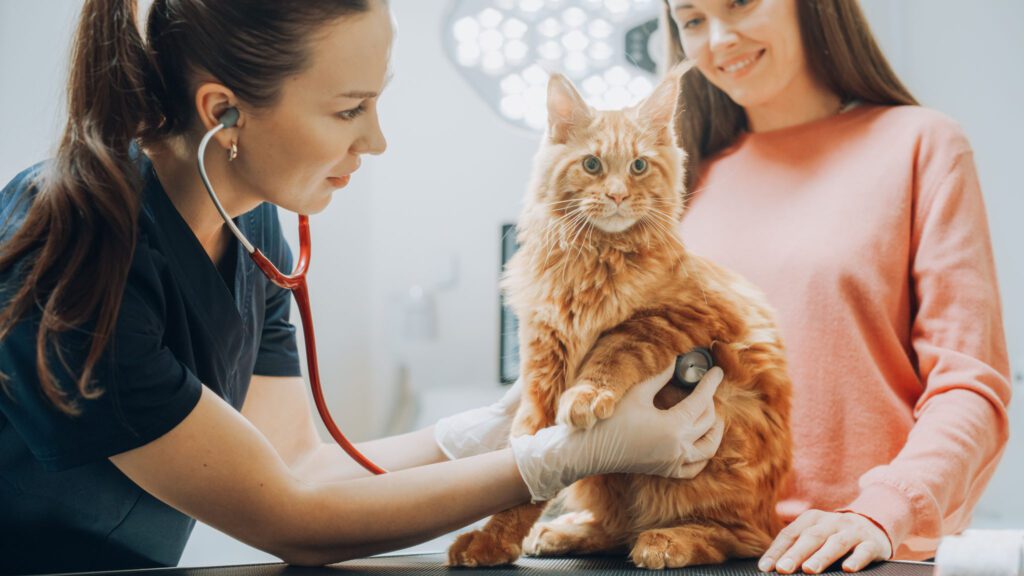What to Expect at Your Pet’s Evaluation
Prior to the evaluation, owners will be provided with a Functional Questionnaire. We recommend completing the packet 1-2 days before the appointment to give us the most accurate representation of your pet’s abilities. This packet will let the therapists know what you are noticing at home, what we can improve, and what you hope your pet gain through therapy. At your recheck, you will be asked to fill out the questionnaire again, allowing us to track their progress throughout the program. During the appointment the pet is taken for a solo evaluation, and measurements (discussed below) with a certified rehab therapist. Once the evaluation is completed, you will join your pet and the therapists to discuss the areas of concern. The therapists will discuss with you what modalities are best suited to your pet and the duration of treatment needed. The first modality and initial exercise program will be completed during the evaluation. Depending on the pet’s needs, we offer the following pain relieving and muscle strengthening modalities: Low Level Laser Therapy, Pulsed Electromagnetic Fields, Kinesiology Taping, Underwater Treadmill, Electrical Stimulation, Manual Stretching and Massage, and a Home Exercise Program.
Initial Consultation: We require a deposit, which covers the cost of the examination and reserves your appointment. This will be deducted from your services that day. If you do not communicate or arrive as scheduled, this is non-refundable.
Gait Analysis
Each pet is given a lameness and neurologic score out of 5 at a walk and trot. This evaluation informs us of your pet’s willingness to bear equal weight on each leg. Minor pain can create an imbalance in your pet’s gait, and therefore lead to compensatory problems and possibly more injuries from overuse. While an abnormal gait will give the therapists an idea of what is most painful to your pet, it will also tell them where to look for compensatory injuries as well. It is monitored at each follow up appointment, alerting the therapists to any improvement or concerns during the program.
Strength Testing
At the evaluation, each limb is assigned a score based on strength. Strength is determined through exercises and activities that show how well your pet is able to support themselves on all of their limbs. The strength score allows the therapist to determine what exercises will most benefit your pet. As your pet improves, the exercises advance with them, further improving their strength and abilities.
Measurements
A baseline muscle measurement is recorded during the evaluation using a spring tension measuring tape, Gulick II. This measurement is repeated at re-checks to keep track of muscle gain or loss throughout the program. Most pets with injuries begin to lose muscle mass in the affected limbs fairly quickly, and it is not uncommon for there to be a 3-7 cm difference between limbs only a few weeks after an injury. The goal of therapy is to build muscle mass where needed, therefore enabling proper use of each limb, and decreasing the chance of compensatory injuries.
A goniometer is used to evaluate any restrictions or excessive movement in the joints of your pet. This tool measures passive range of motion, and helps to diagnose any abnormalities with your pet’s extension and flexion. Restrictions or excessive movement in joints can lead to a compromised gait pattern, resulting in muscle loss and compensatory injuries. As your pet advances through the program these measurements are repeated and compared to the baseline to evaluate progress.
Orthopedic Exam
The orthopedic examination is a vital part of every pet’s evaluation. Therapists check for abnormalities in the joints such as bony and arthritic changes. In some cases, radiographs will be needed to fully evaluate the joints and get a more accurate diagnosis. Each joint is checked for fluid build up, signs of heat or infection. In post-op cases, incisions are evaluated to ensure proper healing is occurring. Knees are assessed for any meniscal or cruciate injuries, and instability. These factors are used to determine what your pet may be experiencing, and help form a treatment plan for your pet.
Neurologic exam
During the evaluation, the limbs will be tested for any neurologic deficits. Pets who are geriatric, have spinal cord injuries, or even knee injuries can experience deficits. Reflexes are tested using a reflex hammer, similar to humans. Pinching of the toes and body is also used to determine if there is a pain reflex present, or the automatic withdrawal of the tested area. Proprioception is defined as the perception or awareness of the position and movement of the body. A decrease or absence in the pet ability to correct paw placement can lead to dragging of the limbs, knuckling, and unusual gait patterns. In neurologic pets, exercises are used to re-train the brain and acknowledge where their paws and body are in space.
Tailored Home Exercise Program
A home exercise program is used to help increase range of motion, mobility, and strength. Each program is unique to your pet’s case. At follow-up appointments, we will run through each exercise and evaluate if your pet is ready to advance to a more challenging level. A handout will be provided to you with all of the advised exercises and their frequencies. With the program, you have the ability to access an online account that provides you with exercise descriptions and videos if you need further explanations.
Low Level Laser Therapy
Low Level Laser Therapy uses light energy to help accelerate healing and anti-inflammatory properties. At AHDC, there are two different lasers available to treat your pet, a class IIIB and a class IV. The IIIB is a point to point laser that is used to deliver a dose of energy directly into the joint being treated, or a trigger point in a muscle. While it uses less power overall, its exact dose administration has shown to be extremely effective for our patients. The class IV scanning laser allows the therapists to deliver a higher amount of energy to a larger area. It is used for neurologic conditions that often require double the amount of energy than what is used to treat arthritis or post-op joint conditions. Your pet may experience a tingling sensation, or mild heat during this treatment, but it is not painful.
Manual Therapy
Massage and stretching is used to help relieve muscle spasms and restrictions in your pet. They increase blood flow and circulation to the area, helping to decrease any swelling and inflammation that may be present. Therapists also have the ability to provide joint mobilizations. These mobilizations are micro-movements applied to their joint capsules, stretching them to provide pain relief and improved range of motion. Restrictions in the joint capsules can lead to a compromised gait pattern in your pet. When your pet is not walking normally, it can cause over compensation in another body part. This leads to over-use of other limbs, increased pain and further mobility restrictions.
Pulsed Electromagnetic Fields
PEMFs are electrical currents used to enhance bone and tissue healing, as well as aid in pain control. This modality specifically works with the to help relieve inflammation. PEMF’s have been shown to provide calming effects to the patients as well. During your pet’s massage, we will provide a PEMF bed for them to receive these benefits. These treatment options are also available for owners to do at home with the rental or purchase of an Assisi Loop. More information on the loop and its benefits can be given at the time of your pet’s appointment.
Electrical Stimulation
With the use of electrical currents, Electrical Stimulation, or E-stim, can be used for both pain management and muscle strengthening.
For pain relief, small electrical impulses are applied to inhibit the nerves from transmitting pain signals to the brain. These impulses also produce natural pain relievers known as endorphins. When used, a visible twitch is noted in the targeted muscles. For strengthening, it can be used in pets experiencing generalized weakness, neurologic issues, or those having trouble activating certain muscles on their own. In such cases, the impulses can be applied to these muscles. The impulses are then increased to the level of muscle contractions, causing the limb to move and over time this movement strengthens and targets muscles. While this will probably feel a little odd to your pet at first, most are able to adjust quickly and relax during this treatment.
Underwater Treadmill
Our underwater treadmill is a versatile and valuable modality. The water provides a temperature controlled buoyant atmosphere for your pet, while also providing resistance. This relieves unwanted pressure on the joints, while still allowing for muscle strengthening. The therapists will adjust the water height to achieve the desired level of buoyancy and surface tension. Higher water levels provide more buoyancy, while lower levels require the pet to support more of their body weight, step through surface tension, and result in a more intense workout. Based on your pet’s abilities and progress throughout the program, the levels will be adjusted as necessary. The treadmill belt can be inclined to increase the difficulty of the therapy and target specific muscle groups. The water is heated to a desired temperature, allowing muscle relaxation and increased blood flow during the treatment. These features are adjusted for geriatric, neurologic, post-op, and even weight loss patients. To get your pet used to the treadmill, we begin by walking the pet in and out of the doors to get acclimated to it. Once the pet is comfortable we will close a door and start the belt, allowing them to walk on it dry. Finally, water is added when the pet is ready. Some patients will require a therapist to be in the water with them during their sessions, but most are able to become so comfortable, they can complete it with minimal guidance from the therapists. Even dogs who do not like water have done great in the underwater treadmill, and some have even learned to love it.
Kinesiology Tape
Kinesiology Tape is a versatile tool that is applied in a manner that helps lift the superficial skin layer, providing tissue decompression. Tissue decompression has two main benefits- improved circulation, and immediately reducing the perception of pain. Without the compression on the free nerve endings, the amount of pain signals that are sent to the brain is decreased. Improved circulation helps to remove any build up swelling and inflammation. The tape also provides sensory input to the brain, letting neurologic pets know where the affected body parts are in space and aiding in proprioception. If deemed helpful for your pet, it will be applied in hospital, and should fall off in a few days. However, it is not digestible and must be removed if the pet chews on it. Owners can also be shown how to apply the tape at home for long term use.
We Care About You And Your Pet

Experience
Caring for pets since 1962.
Knowledge
Unparalleled medical care in a compassionate atmosphere.
Partnership
We listen and partner with you to provide the best care for your pet.
Learn More from our Blog!
Caring for Furry Friends
Harrisburg
- Hours
Mon – Fri: 8:00am – 8:00pm
Saturday: 9:00am – 5:00pm
Sunday: Closed
- Location
- Phone
Linglestown
- Hours
Mon – Fri: 8:00am – 6:00pm
Saturday: Closed
Sunday: Closed
- Location
- Phone
